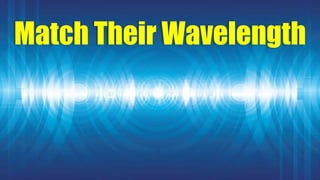How To Speak To Them On Their Wavelength
- 2. A lot of scientific principles are intuitive.
- 3. Not that we know the equations and underlying theory, but as operational humans, we "get" how things work.
- 4. Like throwing a baseball, for example.
- 5. Physics tells us that the optimum angle is 45 degrees if we want to get the maximum distance.
- 6. But kids know this intuitively, by trial and error.
- 7. Another one is the idea of resonance.
- 8. All systems have a certain "frequency" about which they normally vibrate.
- 9. And if you "behave" in this same "frequency" you'll get the most bang for your buck.
- 10. Like little kids on swings.
- 11. They learn quickly to swing their legs at the same frequency as the swing, and they get some pretty high amplitudes.
- 12. Sometimes this is not appropriately understood, with horrible results.
- 13. A group of solders were marching across a bridge, in cadence, and their marching cadence was the same frequency as the bridge. And it collapsed.
- 14. When you're having a conversation with somebody, getting "in tune" with them feels fantastic. Like you are on the same page, or even the same "wavelength."
- 15. Most people think that this happens randomly.
- 16. Haphazardly. Talk to enough people, and a small enough percentage will have that "in synch" feeling.
- 17. Of course, if you approach others with this mindset, it WILL be a numbers game.
- 18. Meaning if you go up and blurt out a bunch of stuff, and hope it "works."
- 19. But if you do the opposite, you'll have a much HIGHER chance of creating that feeling of resonance.
- 20. Instead of blurting out a bunch of stuff, you ask them some questions.
- 21. Easy to answer questions. Simple questions. Then slowly expand.
- 22. Once you get enough information, about what makes them tick, then the "stuff" that you "blurt out" will be much more "in tune" with them.
- 23. And you'll be able to create that feeling of resonance with almost anybody.
- 24. What would you be able to do then?

























